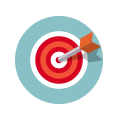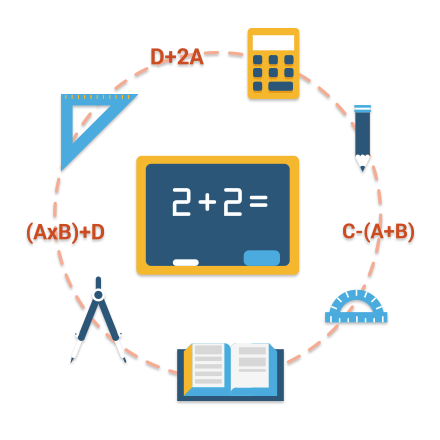Key Stage 3 Maths
When you move onto secondary school or high school you will start studying Key Stage 3 mathematics in Year 7 Maths until Year 9 Maths. You will start by studying fractions at a much deeper level; creating improper fractions, multiplying and dividing to obtain equivalent fractions, multiplying fractions by whole numbers and finding equivalent fractions. One of the biggest differences in terms of difficulty between Key Stage 2 and Key Stage 3 mathematics is the introduction of algebraic expressions. You will be taught how to simplify and expand algebraic expressions whilst also learning how to solve algebraic equations. The workload at Key Stage 3 is also more heavily loaded than at previous stages, you will also be introduced to area, volume, mass and surface area and you will be expected to be able to solve problems which include all of these topics and formulae. Once you have completed Key Stage 3 mathematics you will be fully prepared to move onto Key Stage 4 mathematics which will take you towards your key GCSE maths examinations.
.Popular Maths Curriculum Courses in England..
Key Stage 3
Year 7 Maths
Year 7 introduces topics such as reducing fractions to lowest equivalent form, factors by grouping, and comparing and ordering areas.
Key Stage 3
Year 8 Maths
Some of the topics covered include geometric transformations, sequences and series, changing the subject of formula and statistics.
Key Stage 3
Year 9 Maths
Year 9 explains topics such as trigonometric ratios, constructions and loci, circumcentre and incentre and Pythagorean triples.
Key Stage 4
Foundation Maths
Experimental probability, relative frequency, equations involving grouping symbols are some of the areas taught in Foundation Maths.



KS 3 Maths Topics
#
TOPIC
TITLE
1
Counting and numeration
Addition to 9999 and beyond
Objective: On completion of the lesson the student will be able to use the student’s knowledge of place value to solve addition problems with 3, 4 and 5 digit numbers and word problems.
2
Subtraction
Subtraction involving four digit numbers and beyond using the renaming method.
Objective: On completion of the lesson the student will be able to use written methods to solve subtraction problems involving 4 and 5 digit whole numbers.
3
Multiplication
Multiplying 2-digit numbers by 2-digit numbers
Objective: On completion of the lesson the student will be able to multiply any 2 digit number by any other 2 digit number.
4
Multiplication
Multiplying 4-digit numbers by 3-digit numbers
Objective: On completion of the lesson the student will be able to multiply any 4 digit numbers by any 3 digit numbers using long multiplication.
5
Multiplication
Multiplying 4-digit numbers by 4-digit number
Objective: On completion of the lesson the student will be able to be able to multiply any 4 digit number by any other 4 digit number using long multiplication.
6
Division/repeat subtraction
Repeated subtraction with divisors greater than 20 with remainders as fractions
Objective: On completion of the lesson the student will be able to use long division by repeated subtraction with divisors greater than 20 and remainders expressed as fractions
7
Division/repeat subtraction
Repeated subtraction with divisors less than 35 with some remainders
Objective: On completion of the lesson the student will be able to use long division by repeated subtraction with divisors less than 35, with some remainders.
8
Division/repeat subtraction
Repeated subtraction with divisors less than 55 with dividends of 3 and 4-digits with some remainders
Objective: On completion of the lesson the student will be able to use long division by repeated subtraction with divisors less than 55 and where dividends are 3 and 4 digit numbers, and there are some remainders.
9
Division/repeat subtraction
Repeated subtraction with divisors greater than 50 with dividends of thousands and some remainders
Objective: On completion of the lesson the student will able to use Long Division by repeated subtraction with divisors greater than 50 including division of thousands, and some remainders.
10
Algebraic expressions
Directed numbers: addition and subtraction.
Objective: On completion of the lesson the student will be able to add and subtract positive and negative numbers in any combination, and understand adding and subtracting positive and negative pronumerals.
| # | TOPIC | TITLE | |
|---|---|---|---|
| 1 | Counting and numeration | Addition to 9999 and beyond | |
| Objective: On completion of the lesson the student will be able to use the student’s knowledge of place value to solve addition problems with 3, 4 and 5 digit numbers and word problems. | |||
| 2 | Subtraction | Subtraction involving four digit numbers and beyond using the renaming method. | |
| Objective: On completion of the lesson the student will be able to use written methods to solve subtraction problems involving 4 and 5 digit whole numbers. | |||
| 3 | Multiplication | Multiplying 2-digit numbers by 2-digit numbers | |
| Objective: On completion of the lesson the student will be able to multiply any 2 digit number by any other 2 digit number. | |||
| 4 | Multiplication | Multiplying 4-digit numbers by 3-digit numbers | |
| Objective: On completion of the lesson the student will be able to multiply any 4 digit numbers by any 3 digit numbers using long multiplication. | |||
| 5 | Multiplication | Multiplying 4-digit numbers by 4-digit number | |
| Objective: On completion of the lesson the student will be able to be able to multiply any 4 digit number by any other 4 digit number using long multiplication. | |||
| 6 | Division/repeat subtraction | Repeated subtraction with divisors greater than 20 with remainders as fractions | |
| Objective: On completion of the lesson the student will be able to use long division by repeated subtraction with divisors greater than 20 and remainders expressed as fractions | |||
| 7 | Division/repeat subtraction | Repeated subtraction with divisors less than 35 with some remainders | |
| Objective: On completion of the lesson the student will be able to use long division by repeated subtraction with divisors less than 35, with some remainders. | |||
| 8 | Division/repeat subtraction | Repeated subtraction with divisors less than 55 with dividends of 3 and 4-digits with some remainders | |
| Objective: On completion of the lesson the student will be able to use long division by repeated subtraction with divisors less than 55 and where dividends are 3 and 4 digit numbers, and there are some remainders. | |||
| 9 | Division/repeat subtraction | Repeated subtraction with divisors greater than 50 with dividends of thousands and some remainders | |
| Objective: On completion of the lesson the student will able to use Long Division by repeated subtraction with divisors greater than 50 including division of thousands, and some remainders. | |||
| 10 | Algebraic expressions | Directed numbers: addition and subtraction. | |
| Objective: On completion of the lesson the student will be able to add and subtract positive and negative numbers in any combination, and understand adding and subtracting positive and negative pronumerals. | |||
See More Topics Covered in Key Stage 3
..









